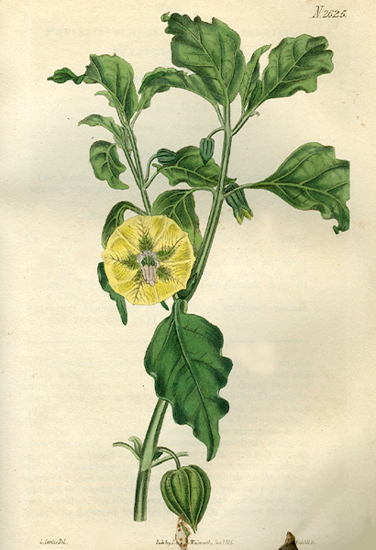
Synonymy
*Physalis viscosa L., Sp. Pl. 1: 183 (1753)
T: "Habitat in Virginia, Bonaria."; Lectotype : Herb. Linn. No. 247.3 (LINN) fide Symon in J. Adelaide Bot. Gard. 3 : 158 (1981). See The Linnaean Plant Name Typification Project pages on the Natural History Museum site.
Description
Rhizomatous perennial to 30 cm, sparsely pubescent with minute, forked hairs at least on calyx margin.
Lower leaves alternate; lamina ovate-lanceolate, up to 5 cm long; upper leaves often 2 per node (but not opposite), lanceolate, c. 3 cm long; margin toothed or sinuate, sometimes entire; base cuneate; petiole to 2 cm long, narrowly winged above.
Pedicels 7–12 mm long. Calyx 6–10 mm long; lobes triangular, 2–4 mm long. Corolla rotate or 5–angled, 11–15 mm long, pale yellow, often with conspicuous olive-yellow blotches towards base. Anthers 3–4 mm long. Style 9–10 mm long.
Fruiting calyx 10–angled, 15–20 (occasionally to 30) mm long, dull yellow-green, drying to pale brown or straw-colour. Berry globular, 10–15 mm diam. Seeds disc-shaped, 1.7–2.3 mm long, pale yellow or light brown.
Distribution and ecology
Widespread in Vic. and southern N.S.W.; localised in south-eastern Qld, near Adelaide, S.A., and Perth, W.A. Now considered to be native only to S. America, although some literature (e.g. Symon, Fl. S. Austral. 3: 1254 (1986)) also records it as native to N. America, presumably because of the location given for the type. See Sullivan, J. (1985). Systematics of the Physalis viscosa complex. Syst. Bot. 10: 426-444 and Sullivan, J. (2004) Rhodora 106:305-326.
A weed of waste ground particularly along railway lines, and of cultivated areas, especially under irrigation.
Common name
Sticky Cape Gooseberry, Sticky Ground Cherry
Notes
A table showing differences between some of the commoner groundcherry species, including this one, can be seen at www.cdfa.ca.gov/phpps/ipc/weedinfo/physalis-table.htm
An account of this weedy species may be found in W.T. Parsons & E.G. Cuthbertson, Noxious Weeds of Australia, Inkata Press, Melbourne 604–606 (1992).
Selected specimens
W.A.: Bunbury, Mar. 1942, C.A. Gardner (PERTH). S.A.: Darlington, Hj. Eichler 12166 (AD). Qld: Goondiwindi, R. Roe 28 (BRI, CANB). N.S.W.: Savernake, 7 Apr., 1978, M. Toms (ADW, NSW). Vic.: near Gunbower, H. Aston 519 (MEL).
Derivation of epithet
From viscosus, Latin for sticky.
Images and information on web
Information on this species in NSW can be seen on the PlantNet site at http://plantnet.rbgsyd.nsw.gov.au/cgi-bin/NSWfl.pl?page=nswfl&lvl=sp&name=Physalis~viscosa
Information about Physalis species as weeds in California can be found on the Encycloweedia pages at http://www.cdfa.ca.gov/phpps/ipc/weedinfo/physalis.htm
Further information and links for P. viscosa can be found on the Plants for A Future site at www.ibiblio.org/pfaf/cgi-bin/arr_html?Physalis+viscosa&CAN=LATIND
Information about the possible toxic properties of Physalis species can be found with a search in the FDA Poisonous Plant Database
Note: with the confusion surrounding the application of names in Physalis, information given on the web which is species specific should be viewed with some caution.



